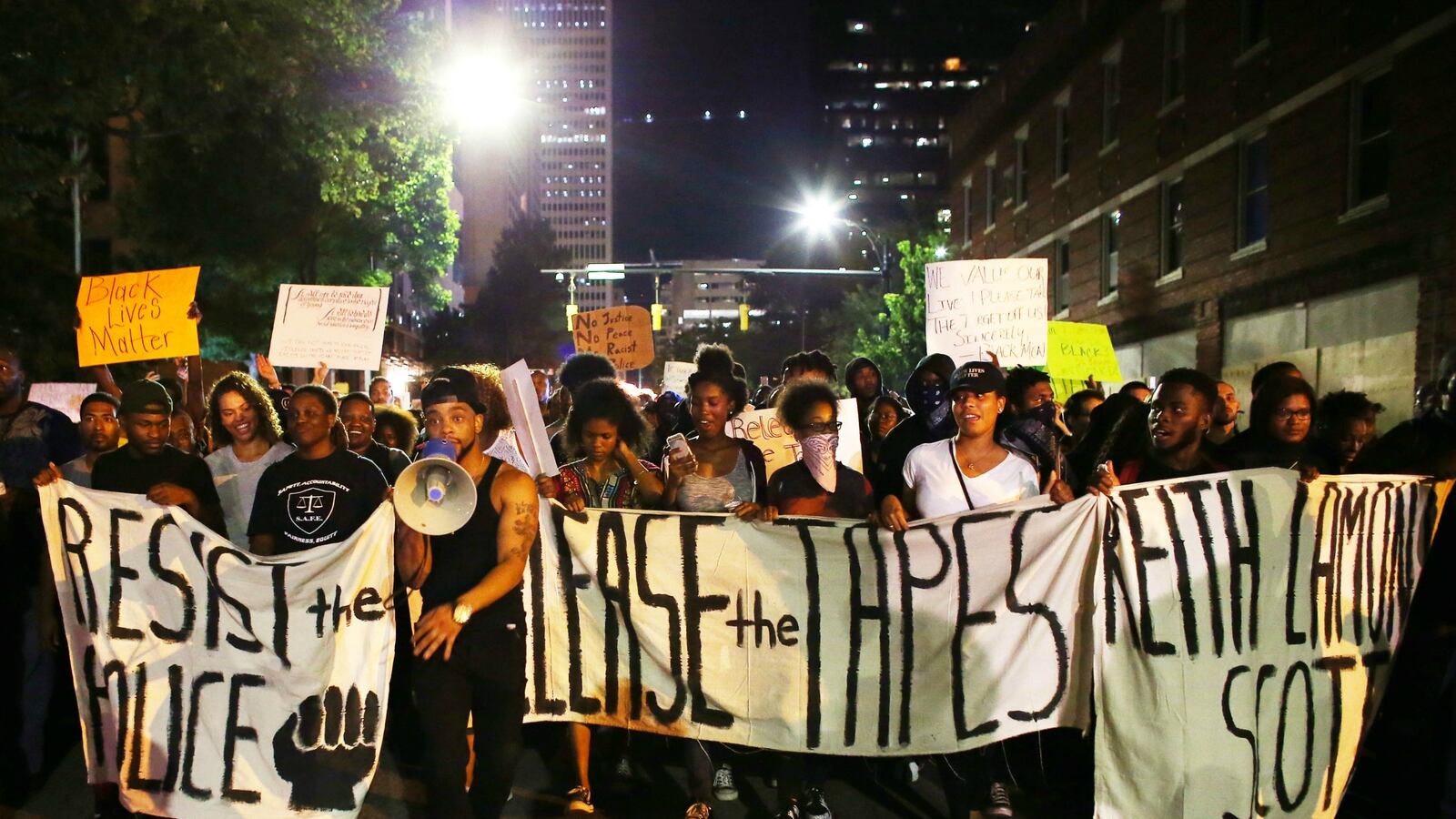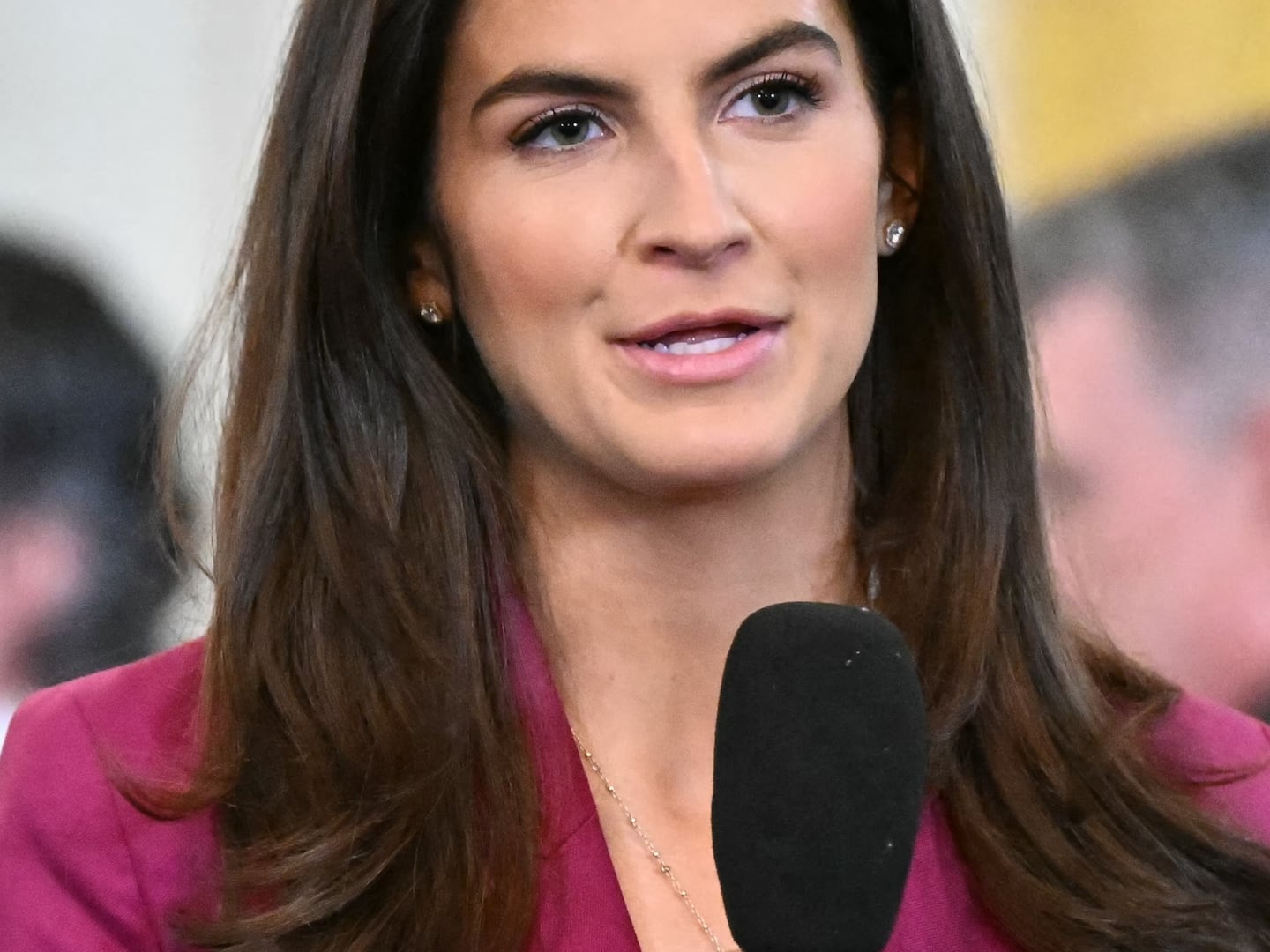As the first images of Charlotte protesters flashed across the television screen, I sat straight up and balled my fists into my chest as I began to rock and cry—for the scene unfolding Wednesday night, for the centuries-long injustices that have divided cities and towns like it across the country, and for the death of another reportedly unarmed black man.
I tried, with no avail, to soothe myself with the words of Dr. King: “A riot is the language of the unheard.”
That the police officer who shot Keith Lamont Scott to death—as he sat waiting for his child’s school bus to arrive—was black changed nothing for me. It almost certainly did not for the throngs of black, brown, and white people who filled the streets of the Queen City for three consecutive nights. It is, after all, comparatively rare for an African-American cop to kill a suspect in the line of duty.
According to tracking data released by Pro Publica, black officers pull the trigger in only 10 percent of all fatal incidences. And, when they do, eight out of 10 of the suspects are black. That statistic was not likely known to the mass of protesters who took over Tryon Street and other avenues, climbed atop the marquee of the uptown Ritz Carlton Hotel, or bashed random car windows.
The language of the unheard.
Keith Scott was black—an allegedly unarmed, black husband and father, living with disabilities. He had a traumatic brain injury, sustained in a 2015 motorcycle accident. The officer who shot him was black too, but the demonstrators would have been no less prone to believe the shooting was unjustified if he had been white.
The only color they saw, the only one that mattered for them, was blue. Still, I watched tearfully and conflicted as an all too familiar set of events played out. There had been Ferguson, Baltimore, Chicago, and Oakland.
Despite calls by some social justice activists to diversify police departments and specifically recruit officers to serve in their own neighborhoods, there is no evidence that those demographic ties would result in fewer shooting deaths—even when the officer and the victim are both black. Implicit bias in policing, believing a black suspect older and more prone to criminality despite no specific prior knowledge of an individual’s background, crosses the racial divide.
While the lion’s share of officers involved in the fatal shooting of suspects are white—responsible for nearly 70 percent of the people of color killed—the number of unarmed victims of color is exponentially higher no matter the race of the officer.
I embraced the pain for a time, as the mayor called for a midnight curfew, allowing it to burn through me like the fires that alight on the streets of Charlotte, wondering how or even if the city would reconcile itself to the work that undoubtedly lay ahead. There are two Charlottes—one largely black and poor, the other mostly white and affluent.
The shooting death of Keith Scott laid bare the economic and racial divide that has persisted throughout its 261-year history. The social contract, built on post Jim Crow self-segregation, maintained a fragile peace for decades.
Charlotte believed itself to be different, a post-racial city, only to see its differences rupture with a single flashpoint.
To be black and male, living in America, is to live under near constant fear of “mistaken identity” irrespective of the ethnic background of the responding officer. Whether confused for an actual suspect description sought by law enforcement or regarded immediately as inherently prone to violence and, thus, an explicit threat during otherwise routine encounters, in data drawn from reports filed between 2010 to 2012—the three most recent years for which FBI numbers are available, tabulated by Pro Publica—black men are 21 times more likely than their white peers to be killed by police.
These are our husbands, fathers, and brothers. All too frequently, when we raise our voices about the demonstrably inequitable encounters with law enforcement and recorded disparities in police violence, when we complain about invariably broad physical descriptions or about the shooting of unarmed victims, our voices fall on deaf ears—among public policymakers and police unions, alike.
And, when a black officer is involved, their ethnicity is often used a counter-argument to racial animus—as if an African-American cop cannot harbor implicit or explicit bias against other people of African descent—by a cast of cultural conservatives. For them, bigotry is dead and the presence of a badge is exculpatory evidence. They believe, specifically in the case of Keith Scott, that the blackness of the officer is irrefutable proof that race played no role in his killing.
They are the same people who would have you believe that 12-year-old Tamir Rice drew his toy gun on a Cleveland cop or that Eric Garner simply died from asthma complications when he was choked-out by an undercover New York City police officer. Of the litany of high profile deaths of suspects during police encounters over the last three years—including Rice and Garner—all of the officers involved were white. But, as studies show, black officers are not immune to acting on their racial biases—implicit or explicit—even if they are involved in fatal shooting less frequently.
I do not claim to know the mind of Brentley Vinson, the officer who shot Keith Scott, but, clearly, black officers are not immune to anti-black attitudes or other forms of racial bias.
This I know: Without question, black officers have participated in and even led the implementation of policing practices—as beat officers, unit commanders, and police chiefs—that have resulted in disparate outcomes in non-white communities. The 1994 federal legislation that prompted and partially funded the hiring of new police officers—and brought more African-American men and women into the ranks—is universally understood to have resulted in over-policing in non-white neighborhoods and the mass incarceration of black people. Arguably, the Violent Crime Control and Law Enforcement Act and companion pieces of state legislation did more to solidify and advance post-Jim Crow segregation, specifically by race and income, than any other law enacted in the last 50 years.
Today, the public discourse is littered with a cacophony of voices—from CNN’s Jeffrey Lord and retired homicide detective Harry Houck to former New York mayor Rudy Giuliani—who argue that aggressive targeted policing in predominantly black neighborhoods is not only vital to the common good but also warranted based on the criminal proclivities of the people who live there.
“Ninety-three percent of blacks in America are killed by other blacks. We’re talking about the exception here,” Giuliani said on NBC’s Meet the Press.
He failed, of course, to note that 84 percent of white victims are killed by white offenders and that violent crime is overwhelmingly intra-racial. But, Giuliani is not alone. Milwaukee County Sheriff David Clarke called black-on-black crime and public uprisings a function of “black cultural dysfunction.” He blames single parenting and told Fox News, “If they really took a look at what was going on around them, what they’d be railing against is not the police and the police use of force.”
And, after unrest ensured in Ferguson, Missouri, in the wake of the death of 18-year-old Mike Brown, he called protesters “vultures on a roadside carcass.”
Clarke and I see things quite differently.
You see, in 2014, I witnessed first-hand the unrest Ferguson where I once lived. Ironically, I attended Normandy High School nearly 30 years before Michael Brown walked its halls and I am personally familiar with policing-for-profit in North St. Louis County. Then, months after Ferguson, I led a reporting team into Baltimore where I watched rioters loot a liquor store and burn down a pharmacy in 2015. I investigated Freddie Gray’s “rough ride” and each of the six officers—black and white—who were involved. Then too, I went to North Charleston, South Carolina, and traced the last steps of 50-year-old Walter Scott, who was chased down and shot in the back five times by former police officer Michael Slager who was recorded planting a weapon on the victim.
And I tend to agree with Rev. William Barber III, president of the North Carolina NAACP, when he says, “To condemn the uprising in Charlotte would be to condemn a man for thrashing when someone is trying to drown him.”
“A riot,” Dr. King echoed again in my head, “is the language of the unheard.”
For the record, I have known both white and black officers who hid their misdeeds behind the cover of a shield and the “good” officers who protected them.
“Better to be judged by 12, than carried six,” my stepfather, a retired chief city homicide detective and state fugitive squad captain, reminded us when we were coming up in East St. Louis.
When my mother’s husband walked the beat, there were no squad car dashboard cameras and it was years before the proliferation of civilian smartphones with videotape capability. Today, there is greater scrutiny—thanks in part to Sunshine Laws and social media—when an officer fires their gun. However, until officers of the law—black and white—are trained to eschew implicit and explicit racial biases and to advance equal protection, we can expect more national news stories and more unfortunate social media hashtags. Given the statistical outcomes, until those informing prejudices are rooted out, we know—without failing—that there will be another Keith Scott.






